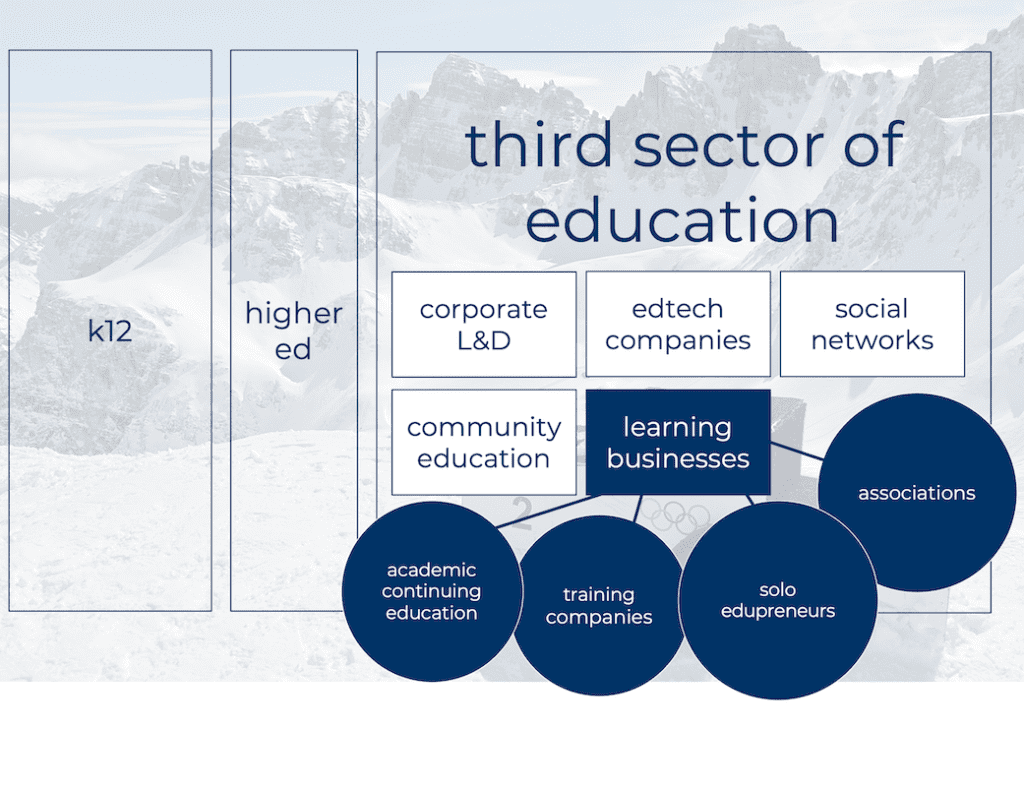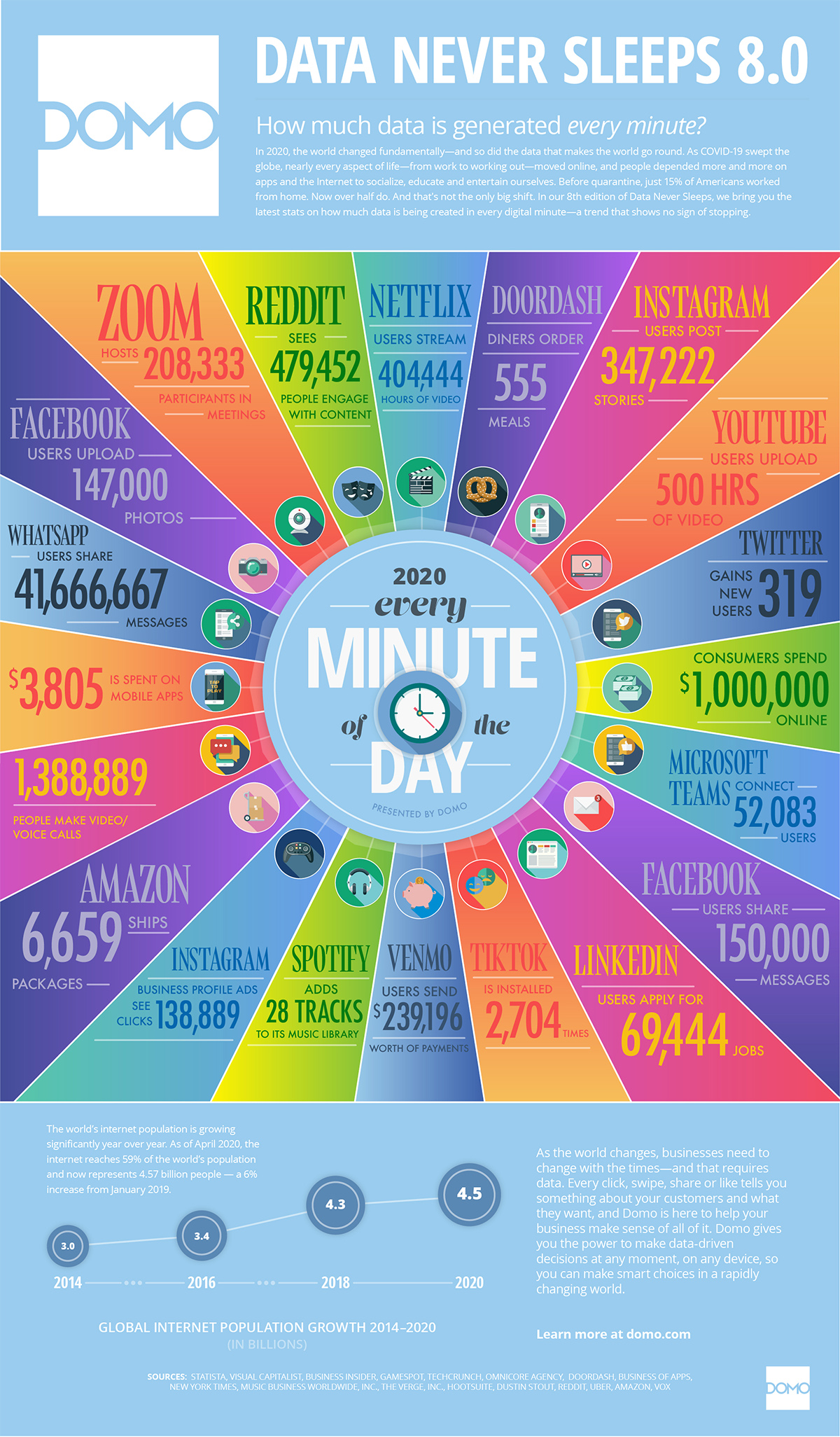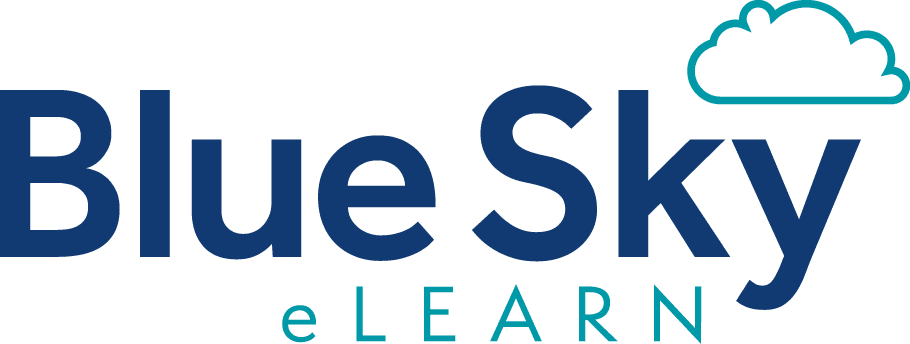It’s a new year and we’re kicking it off with another seven-episode series of the podcast. Our previous series focused on the learning business in disruptive times, but this time we’ll be exploring the surge of the third sector of education—particularly the related implications this has on learning businesses.
In this episode, we delve into some background behind the third sector of education including what it is, factors that have led to its tremendous growth, and why it is so important. We also preview the four interviewees we’ll be talking with later in the series and the unique perspective they each bring to the topic.
To tune in, just click below. To make sure you catch all of the future episodes, be sure to subscribe by RSS, Apple Podcasts, Spotify, Stitcher Radio, iHeartRadio, PodBean, or any podcatcher service you may use (e.g., Overcast). And, if you like the podcast, be sure to give it a tweet!
Listen to the Show
Access the Transcript
Download a PDF transcript of this episode’s audio.
Read the Show Notes
[00:18] – A preview of what will be covered in this first episode of a seven-part series related to the surge of the third sector of education.
Defining the Third Sector of Education
[01:21] – We’re calling this series “the surge of the third sector,” so let’s talk here at the outset of episode 258 about the third sector of education and what we mean by the term.
And what we mean is highly relevant, as “the third sector of education” is a term Jeff coined and we’ve both been using it for several years at this point.
To explain the third sector of education, let’s talk about the other two sectors.
The first sector is the pre-K through high school system that serves children.
The second sector covers higher education that grants degrees to the lucky among us.
Both those sectors are well known here in the United States and in most countries around the world, though the nomenclature may differ.
The third sector of education is less familiar, but it’s definitely not new. That third sector serves the millions of adults who continue to learn and grow in the decades that follow their secondary and post-secondary education.
Many providers make up the third sector: corporate learning and development, learntech companies, even social networking companies like Facebook and LinkedIn, community education, and, of course, learning businesses, which is where Leading Learning focuses.
Learning businesses are a key part of the third sector of education and include academic continuing education units, training companies, solo eduprenuers, and trade and professional associations.

No matter the organization type, what learning businesses have in common is that they are all in a market-facing business that sells education and learning products to adults.
So the third sector and learning businesses are not synonymous. The third sector is bigger; learning businesses are one part of the third sector—a very important part, in our opinion, but not the only part by any means.
And we’re calling this series the “the surge of the third sector” because, while the sector isn’t new, we’ve seen it growing in size and importance in recent years.
Why the Surge in the Third Sector
[03:43] – One indicator of the growth is the financial investment we’ve seen in the sector and the mergers and acquisitions too.
It’s in ways becoming reminiscent of those dot com days back when we first got our start. In the whole learning world though, it’s probably a lot more rational this time.
We’ll just name some of what we’ve seen, but for instance, investment in the learn tech sector.
We saw Thinkific, one of the emerging learning platforms course platforms, get 22 million in investment. LearnUpon got 50 million.
And Bizzabo, which is focused on that virtual events market (which just exploded of course, with COVID coming along), got 138 million.
Also, Udemy, which we often describe as kind of the amazon.com of online courses got 50 million in investment.
Check out our episodes with Thinkific co-founder and CEO Greg Smith and Udemy VP of Learning, Shelley Osborne.
And then we’re seeing acquisitions and we expect to see a lot more of these roll-ups that are happening in the sector.
Community Brands, a big player in the association world bought Pathable, which is another big virtual events provider.
Symphony Technology Group bought EthosCE, an LMS provider, and CadmiumCD, which is focused on events.
We had Open LMS buy eThink, one of the big Moodle and Totara companies that’s out there.
And then Learning Pool bought Remote Learner, which is another one of those big Moodle companies that’s out there.
So there’s a lot of investment and mergers and acquisitions going on, obviously a lot of focus on the potential in this third sector, but what’s driving the growth that’s behind that interest and attention?
[05:49] – We see five developments in recent decades that have laid the foundation for the growth in the third sector.
- Shifts in human life and work. Humans, in general, are living longer—though we should note that the pandemic will likely cause a drop in life expectancy. Final data for 2020 isn’t in yet, but life expectancy may drop by three full years in 2020, the CDC warned. But, still, the overall trend on life expectancy is likely to continue upward. And we are no longer likely to do the same thing over the course of our now-longer working lives. We change jobs and even careers more frequently, driven in part by technology. Automation and artificial intelligence are replacing jobs or, more commonly, altering responsibilities as we harness technology to help humans.
- In recent years, we’ve seen many advances in underlying technologies. The growth of mobile devices, broader Internet availability, and faster Internet through technologies like 5G means more people have the ability to learn anytime, anywhere.
- We’ve seen an incredible surge in content in recent years. In 2020, YouTube users uploaded 500 hours of video every minute. And that is just one type of content on one platform—the same surge is happening across the Internet. The sheer volume of content exacerbates issues around search and trustworthiness. How do people quickly and easily find the most relevant, reliable content when there’s so much information out there? How do they find the signal in the noise?
- Neuroscience and the science of learning have really made great strides in recent years. Scientists have given us previously inaccessible insight into what happens to the brain as it learns. That insight has helped us understand that the old model of finishing your education at age 18 or 22 or 28 or any fixed time is nonsensical. Humans need the time for spaced learning and effortful retrieval and time to apply what we’ve learned. Learning is a process not an event—and it’s a lifelong process.
- Finally, we have an even more recent development, the COVID-19 pandemic. The upheaval and disruption of the pandemic has sharpened the need for many organizations and individuals to be able to learn and adapt quickly, to pivot to new business models or new jobs or new careers as the old ways of doing things became unsafe or unviable.
These five developments all contribute to the growing need for the third sector of education.
We need education that supplements—or replaces—traditional four-year university degrees whose half-life and cost make them increasingly hard to justify.
We need the third sector to help provide access to education that fits the needs of working adults with families who can’t necessarily put their career on hold while they devote a couple years to full-time study or who can’t uproot a family to move to live near a physical campus.
We need the third sector to help us learn about and leverage new technologies like AI.
We need the third sector to help us prepare for new careers and jobs—ones that may not even exist right now—and we need the third sector to help us remain in our current roles too.
We need the third sector to help learners navigate the changes and find the most relevant resources in a sea of information.
Society needs this sector. A vibrant third sector of education is integral to society. The third sector makes the present possible, and it also provides learners with the resiliency to make the leap to whatever the future brings—and it provides learners with the skills and knowledge and insight needed to help shape that future, hopefully for the good of us all.
Interviewees in the Series
[11:26] – Because the third sector of education is made up of many players, and each player brings a different perspective, we are incorporating other voices into this series.
Four conversations are part of the series.
Jeff speaks with Casandra Blassingame, chief executive officer at the International Accreditors for Continuing Education & Training.
Given IACET works with a range of providers of continuing education and training, spanning many disciplines and fields, and given IACET’s role in developing and managing the CEU, we knew Casandra would add a valuable and broad perspective to our look at the third sector.
Celisa speaks with Nigel Paine who has had a long career that’s intersected with the third sector at many points.
He’s been in involved in corporate learning for over twenty years, and from 2002 to 2006 he headed up the BBC’s Learning and Development operation.
He’s written three books in the last five years, including Workplace Learning: How to Build a Culture of Continuous Employee Development.
He co-hosts the From Scratch podcast on workplace issues, and he’s a presenter for Learning Now TV, a live-streamed Internet TV channel for those focused on corporate learning and performance.
Nigel also teaches in the chief learning officer doctoral program at the University of Pennsylvania.
So he has a lot to draw on when commenting on the third sector, and he brings a non-U.S. perspective—Nigel is based in London and has consulted with companies large and small in over 30 countries.
Jeff talks with LaTrease Garrison, executive vice president of the Education Division at the American Chemical Society.
ACS has more than 150,000 members, making it the largest scientific society in the world and you might imagine, keeping up with the professional development and education needs of that many scientists is a significant challenge.
We’ve had the good fortune to know LaTrease for a number of years now. She’s been on the podcast before and she once again has invaluable perspectives to share on professional education, lifelong learning, and the role of organizations like ACS in the third sector.
Celisa also talks with Michelle Weise, entrepreneur-in-residence at Imaginable Futures and author of Long Life Learning: Preparing for Jobs That Don’t Even Exist Yet.
That latest book of hers does an excellent job of looking at the shortcomings of the current educational system. And, thankfully, she doesn’t stop at cataloging the shortcomings but posits five guiding principles that the new learning ecosystem we need should incorporate.
Michelle worked and wrote with Clayton Christensen, AKA “the godfather of the theories of disruptive innovation,” and she applies his term nonconsumers to the context of lifelong learning and, in fact, focuses a lot of attention on nonconsumers.
Long Life Learning is based on hard numbers and draws on a ton of interviews conducted with adult learners trying to navigate the third sector.
Michelle has also been on the podcast before, but with her new book, which we highly recommend, and her career that’s been dedicated to those left behind and left out by traditional, degree-focused options, we knew she’d have invaluable perspective to share on the third sector, and so we asked her back.
Sponsor: Blue Sky eLearn
[15:12] – We’re also pleased to share that Blue Sky eLearn is the sponsor for this series. Blue Sky is a company committed to learning businesses and has a long history working to help providers in the third sector.
For nearly 20 years, Blue Sky eLearn has been transforming the way organizations deliver virtual events and educational content. Blue Sky’s customized cutting edge solutions connect hundreds of organizations to millions of learners worldwide.
These include their award-winning learning management system Path LMS, webinar and live streaming services for short events to multi-day virtual conferences, and learning strategy and development solutions. These robust, easy to manage solutions allow organizations to easily organize, track, and monetize educational content.
We’re truly grateful to Blue Sky eLearn for helping to make this series possible, and we’re grateful for Amanda Davis, vice president of continuing education solutions with Blue Sky eLearn, and Liam O’Malley, vice president of association solutions at Blue Sky eLearn, for talking with us and sharing their perspectives on the third sector.
Blue Sky eLearn’s Perspective on the Third Sector
[16:40] – Liam discusses how broader accessibility (related to general availability not in terms of usability for people with disabilities) has implications for the third sector and how providers operate and succeed—so how to stand out among the noise created by the surge in content freely available, how to demonstrate value versus free offerings.
[19:55] – Amanda talks about the level of awareness among players in the third sector of the other players. She brings to mind how sometimes organizations think they’re more knowledgeable about their competitors and the other options their learners have than they truly are.
Organizations that are really attuned to the third sector landscape have the potential to see and understand not only competitors but also potential partners and allies and to see that maybe their biggest competition is not another education provider but the chance that learners might chose nothing—they might opt to be nonconsumers, as Clayton Christiansen and Michell Weise call them.
She also discusses how COVID drove many organizations to up their digital game or to start offering online learning if they weren’t already, but there are also some who resisted and insisted on the way things have traditionally been done. They’re sitting out, they’re sidelined for the moment, and we think she’s right to say that choice will cost them. Online delivery does seem make or break.
Both Liam’s and Amanda’s comments get at some of those fundamental developments that are driving the rise of the third sector.
Liam is looking at accessibility and how that openness changed and is still changing the value proposition for many learning businesses.
And Amanda is right, we think, to suggest that there’s room for more nuance and understanding of the sector among many organizations.
It may be worth questioning whether you really, truly understand the alternatives and options available to the learners you wish to serve.
[24:34] – Wrap-Up
Reflection Questions
Because we believe in the power and value of questioning, we have a couple questions we want to invite you to reflect on:
- What’s your learning business’s awareness of the third sector of education?
- How might a deepened awareness of the third sector help your learning business?
The first question is your level set. It’s a simple question to help you and your team reflect on how you fit into a broader landscape.
That second question can help prod you and your team from reflection to possibility and action. It might suggest new products or services or make the case for sunsetting a product given greater awareness of competitive offerings, or it might show opportunities for partnerships and joint ventures.
Or something else—we intend these questions to be generative, not closed or directive. We don’t want them to lead to facile answers.
We hope that considering these questions will open up possibilities. They may take months to answer, not minutes.
To make sure you don’t miss the remaining episodes in this series, we encourage you to subscribe by RSS, Apple Podcasts, Spotify, Stitcher Radio, iHeartRadio, PodBean, or any podcatcher service you may use (e.g., Overcast). Subscribing also helps us get some data on the impact of the podcast.
We’d also appreciate if you give us a rating on Apple Podcasts by going to https://www.leadinglearning.com/apple.
We personally appreciate your rating and review, but more importantly reviews and ratings play a big role in helping the podcast show up when people search for content on leading a learning business.
Finally, consider following us and sharing the good word about Leading Learning. You can find us on Twitter, Facebook, and LinkedIn.
[27:12] – Sign off
Other Episodes in This Series:
- Long Life Learning with Michelle Weise
- Accrediting Lifelong Learning with Casandra Blassingame
- Reflecting with Anthony Carnevale
- Continuous Development with Nigel Paine
- Uncovering Opportunity in Challenges with LaTrease Garrison
- The Third Sector of Education: Sustaining and Shaping Society









 The 2021 Learning Business Landscape
The 2021 Learning Business Landscape
Leave a Reply